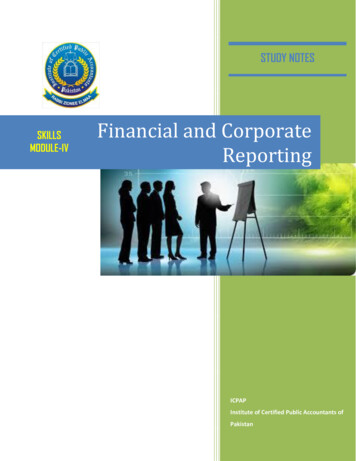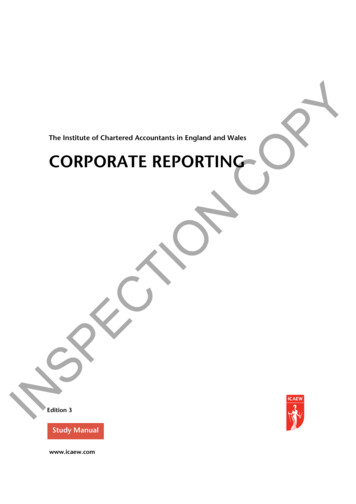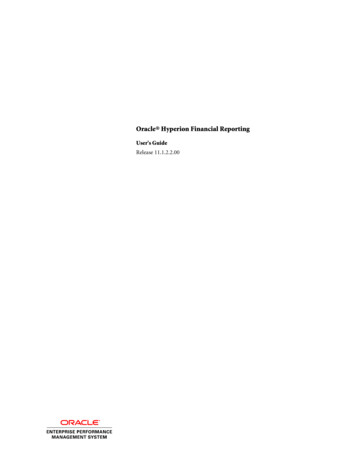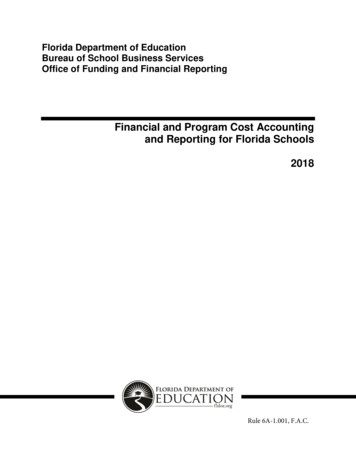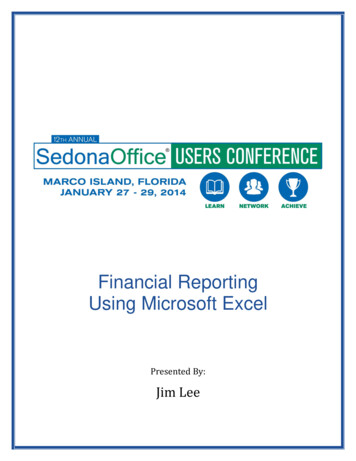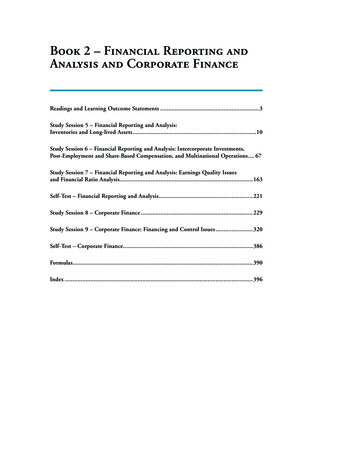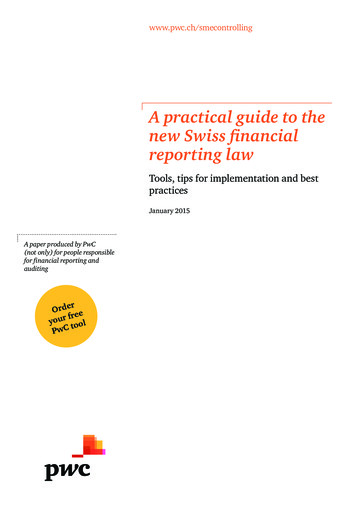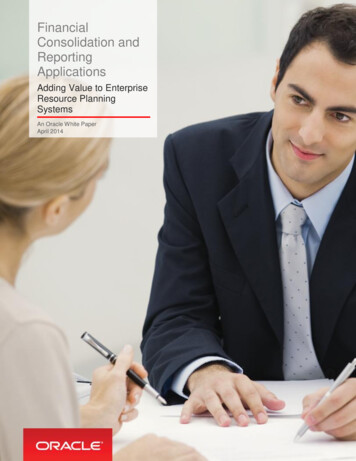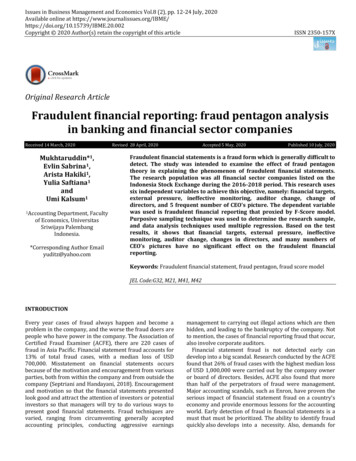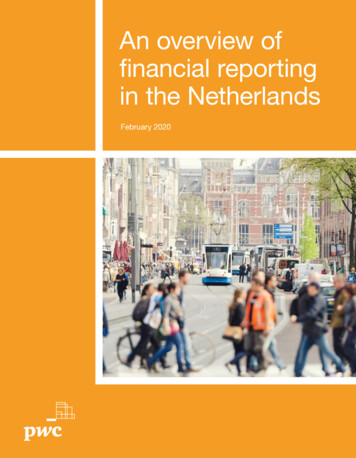
Transcription
An overview offinancial reportingin the NetherlandsFebruary 2020An overview of financial reporting in the Netherlands1
‘Welcome to the latest edition of An overviewof financial reporting in the Netherlands. As thetitle already suggests, this booklet provides ageneral overview of the existing requirements.If you are in need of more information, ouradvisors will be very happy to assist youon an individual basis. On behalf of PwCAccountants, we hope that you will find thisbooklet useful.’
An overview offinancial reportingin the NetherlandsFebruary 2020This booklet is for those who wish to gain a broad understanding of financial reporting in theNetherlands. It is not comprehensive. The legislation on reporting is sometimes extremelycomplicated and changeable. We accept no responsibility for what one undertakes withoutexpert advice in response to the content of this booklet.While every effort has been made to ensure accuracy, information contained in this bookletmay not be comprehensive or details that are relevant to a particular reader may have beenomitted. In particular, this booklet is not intended as a study of all aspects of Dutch GAAP,or as a substitute for reading the Dutch law, the Dutch Accounting Standards, and anyinterpretations and/or judicial decisions when dealing with specific issues. No responsibilityfor loss to any person acting or refraining from acting as a result of any material in thischecklist can be accepted by PricewaterhouseCoopers. Recipients should not act based onthis booklet without seeking professional advice.An overview of financial reporting in the Netherlands3
ContentsPreface4PwC71. Legal framework1.1 The bv and the nv1.2 Setting up a business1.3 Relevant corporate bodies of a company1.4 To be in compliance1.5 Employee benefits1.6 Share capital and dividend payments1.7 Corporate governance9101114182023272. Requirements for annual reports2.1 The composition of the annual report2.2 The size of a company matters2.3 Keeping the books and preparation of the financial statements2.4 Filing of the annual report2.5 Formats of financial statements2.6 Notes to the financial statements313234353638433. The core accounting principles under Dutch GAAP3.1 General principles3.2 Principles on the recognition and measurement of various items3.3 Equity and reserves3.4 A change in accounting policy, change in accounting estimateor a prior period error?4748495457
4. Consolidated financial statements4.1 Definitions and accounting principles4.2 Consolidation and exemption from consolidation (Article 2:407 DCC)4.3 Consolidation exemption for intermediate holding companies(Article 2:408 DCC)4.4 Group exemption (Article 2:403 DCC)4.5 Format and content of consolidated accounts5960625. IFRS in Dutch financial statements5.1 To apply IFRS in the Netherlands5.2 Options available for the consolidated and company financial statements5.3 Parts of Dutch law are still relevant for IFRS appliers in the Netherlands5.4 Overview of the key differences between Dutch GAAP and IFRS69707173746. Company taxation6.1 Resident and non-resident taxpayers6.2 Corporate income tax6.3 Capital tax6.4 Interest and royalty withholding tax6.5 Dividend withholding tax6.6 VAT6.7 Payroll taxes6.8 Reporting requirements6.9 Tax rulings and Tax Authorities79808187878788899091AppendicesAppendix A - Book 2, Title 9 Dutch Civil Code (unofficial translation)Appendix B - TerminologyAppendix C - Authors6365679394118122An overview of financial reporting in the Netherlands5
Hugo van den EndeRenick van OosterboschMaran Smit6PwC
PrefaceThis booklet has been written with the needs ofthe foreign investor (including multinationals withintermediate holdings) in the Netherlands in mindand aims to address many of the recurring questionsraised by clients in practice.It is not intended to be a detailed work of reference,but rather an accessible overview of financialreporting for limited liability companies in theNetherlands, including relevant aspects of law, and forexisting investors who need, or wish to have, a basicunderstanding of the key aspects of establishing andoperating a company in the Netherlands.Industry specific legislation with regard to banks,insurance and investment companies and otherfinancial institutions is not included in this book.This is also the case for any special rules that areapplicable for entities, such as co-operatives,associations, governmental and public sectororganisations.In this book, we refer to Dutch GAAP, which covers:The Dutch Civil Code, Book 2 Title 9 (‘DCC’), plus: The General Administrative Order on model formats(‘Besluit modellen jaarrekening’ –‘GAO on modelformats’); The Decree on valuations (‘Besluit actuele waarde’);and The Dutch Accounting Standards (‘Richtlijnen voorde jaarverslaggeving’).Dutch company law is part of the Dutch Civil Code.The legal provisions relating to entities limited byshares in the Netherlands are included in Book2 of the Code, which contains legal provisionsrelating to all legal persons and entities, includingco-operatives and associations, as well as limitedliability entities.The Dutch Accounting Standards have no legalforce but provide more detailed guidance on theinterpretation of the law and in areas that are notspecifically covered by the DCC. In practice, theDutch Accounting Standards form an importantpart of the Dutch Generally Accepted AccountingPrinciples, which has been confirmed in a numberof legal cases.We based our booklet on Dutch Law and the 2019version of the DAS, which is applicable for financialstatements on annual periods beginning on or after1 January 2020.We are indebted to a number of colleagues for theircommitment to read and check chapters of this bookand for providing constructive comments: KevinBernadina, Arjan Brouwer, Jos de Groot, MichielLohman and Jeroen Tuithof.Specific knowledge was provided for the preparationof the chapters on legal aspects and taxation.Therefore, we would like to thank Tom de Regterfor reviewing the legal content of this booklet; andJune Mentens and Mariska van der Maas of our Taxdepartment for their help.The online version of this booklet can be accessed viathe Dutch branch of www.inform.pwc.com.Enquiries concerning the contents of this booklet maybe addressed to your contact at PwC.PricewaterhouseCoopers Accountants N.V.National OfficeHugo van den EndeRenick van OosterboschMaran SmitAmsterdam, February 2020An overview of financial reporting in the Netherlands7
8PwC
1. Legal frameworkAn overview of financial reporting in the Netherlands9
Dutch corporate law is part of the Dutch Civil Code (hereafter ‘DCC’). The legalprovisions relating to companies limited by shares in the Netherlands are includedin Book 2 of the DCC, which contains provisions relating to all legal persons andentities, including co-operatives, associations, foundations and limited liabilitycompanies. The financial reporting regulatory framework is built upon the relevantelements of the DCC, and is supplemented by the Dutch Accounting Standards(DAS), judicial precedence (‘de Ondernemingskamer’) and International FinancialReporting Standards (hereafter ‘IFRS’). Companies whose securities are listedgenerally also have to comply with the Financial Supervision Act (Wet op hetfinancieel toezicht - Wft).The Dutch Authority for Financial Markets (AutoriteitFinanciële Markten - AFM) also plays a role infinancial reporting in the Netherlands as it supervisesthe correct use of financial reporting rules by listedentities.Both the bv and the nv are separate legal entitieswith share capital. They can be used for the samebusiness purposes, which will be set out in theirarticles of association (hereafter ‘the articles’; refer tosection 1.5).By way of introduction, this chapter sets out the mainaspects of the legal framework relating to companieslimited by shares. The more detailed requirementsrelating to accounting and auditing requirements forcompanies are dealt with in chapters 2 to 5.The bv is a privately held company comparable to theLimited Company (Ltd.) in the United Kingdom andthe ‘Gesellschaft mit beschränkter Haftung’ (GmbH)in Germany. It is possible to block the free transfer ofshares of a bv.1.1 The bv and the nvUnder Dutch corporate law, two types of companieslimited by shares are recognised: bv (besloten vennootschap): the private companywith limited liability; nv (naamloze vennootschap): the public limitedcompany.The nv shares may be wholly or partially publiclyheld, whereas nv shares may also be privately held.The nv type company is comparable to the PublicLimited Company (plc) in the United Kingdom and‘Aktiengesellschaft’ (AG) in Germany. It is possible toblock the free transfer of privately held shares in annv, but not of the publicly held shares.The table below summarises the main features of bothtypes of company.bvnvMinimum share capital 0.01 45,000Transfer of SharesMay be freely transferablePublicly held shares are freely transferable,privately held shares may beStock exchange listing possibleYes1YesConversion from nv to bvor from bv to nv possibleYesYes1 This rarely happens due to the private character of the bv. An example of a partially listed bv is FastNed B.V.10PwC
In practice, most companies are incorporated as abv and then converted to an nv if and when a publicquotation is sought.There are no size restrictions applicable to either thebv or nv except for the minimum legal share capitalrestrictions.It is also possible to establish a EuropeanCompany (SE). An SE, which is incorporated inthe Netherlands, can be compared to the Dutchnv. Furthermore, a European Cooperative Society(SCE) can be established, which is comparable tothe Dutch cooperative, when it is incorporated in theNetherlands. Legal provisions for these companiesare included in European regulations. The financialreporting regulatory framework of an SE and anSCE is subject to the applicable national law. Inthe remainder of this book, we address the Dutchregulatory framework for an nv and a bv.1.2 Setting up a businessThis section deals with the incorporation of acompany, the articles of association and theliquidation of a company.i. Incorporation of a companyThe formation of a new company involves a legalprocedure, which normally takes around two to threeweeks to complete - although in urgent cases thismay be shortened.FoundersThe founder(s) of a company is (are) the individual(or individuals) who in person or by proxy appearat the Dutch civil law notary, executing the deed ofincorporation. The founders usually subscribe to theshare capital in the new company. Founders maybe both natural persons and legal entities, such ascompanies. There are no restrictions on the nationalityor domicile of a founder. The main steps involved in theincorporation process are described below.Deed of incorporationThe key document for the incorporation of a newcompany is the notarial deed of incorporation,executed before a Dutch civil law notary officiating inthe Netherlands.The deed of incorporation includes the followinginformation: The articles of association including inter alia anddetails of the objectives of the company. Provisions on the corporate bodies (the generalmeeting, the management board, the supervisoryboard if that is to be installed or the one-tier boardincluding executive and non-executive boardmembers). Provisions on the shares of the companies’capital that the company is going to issue atthe incorporation and in the final statementsinformation on the issued capital and paymentsmade on such shares.Steps to incorporationThe steps in the incorporation process are as follows:a. A deed of incorporation, which must be in Dutch,is prepared by a Dutch civil law notary officiatingin the Netherlands, who must have the requiredinformation and documents (like articles ofassociation and personal information on boardmembers) needed for the incorporation.b. The future shareholder(s) of an nv must subscribeto at least one fifth of the authorised share capitalof the company which subscription and authorisedshare capital both have to be EUR 45,000 or more.c. The notary executes the notarial deed.d. For payments in cash on the shares of an nv thenotary must obtain confirmation from a Dutch(or European Union) bank before the deed ofincorporation is executed, that the subscriptionfunds are available to the new company. If thesubscription is in a foreign currency, the statementmust give the equivalent in euros.e. Payments in kind on the shares of an nv or abv require a description, to be drawn up andsigned by all incorporators, stating an appraisalof the value of the payments. Such appraisal ofan nv must be certified (usually by a registeredaccountant) to have a value at least equal to theobligation to pay up.f. The civil law notary usually assists with theregistration of the new entity with the TradeRegister of the Dutch Chamber of Commerce.The notary retains the original deed. Certified copieswill be issued.An overview of financial reporting in the Netherlands11
The company is primarily responsible for paymentof the expenses related to its formation, unless it isagreed that the founder will meet these expenses.Company ‘in formation’It is possible for someone to act on behalf of acompany that has not yet been incorporated. Ifone wishes to act in such a way, it is necessary toexpressly state so and to add the abbreviation ‘i.o.’(‘in oprichting’) after the name of the company.Transactions entered into on behalf of the companyin formation, may be ratified by the managementboard of the company after incorporation (and afterthe registration with the Trade Register of the DutchChamber of Commerce has been completed) andwill then bind the company. A warning is due here:should the management board of the company, afterthe formation, not ratify the transaction or contract,the person having acted is personally liable for thattransaction or contract.ii. The articles of associationThe articles of association are the internal regulationsof the company dealing with, for example, proceduresat general meetings and the appointment of membersof corporate bodies, such as the management boardand the supervisory board (if the latter is present).The effect of the articles is to bind the company andits present and future shareholders. Every companymust file articles upon application for registrationwith the Trade Register of the Dutch Chamber ofCommerce, as detailed in section 1.4.Law prescribes part of the content of the articles andthe company’s articles must not conflict with thoseprovisions.Contents of the articlesThe most important contents of the articles aresummarised below. Name and corporate seatThis section states the name of the company andwhether it is an bv or an nv. Any name may be chosen,subject to certain restrictions. The most importantis that the proposed name should not infringe on thetrade name or mark of another company; the notary isable to have suggested names researched to preventsuch infringements.12PwCThe corporate seat of the company will normallybe the same as the principal place of business ofthe company, but it can be any municipality in theNetherlands. Objects clauseThe law requires the objects or purpose of thebusiness of the company to be stated in the articles,to establish the contractual capacity of the company.For practical purposes, the objects clause is normallya short, general description. Authorised share capitalAn nv must have an authorised share capital amount,which is the maximum aggregated nominal valueof the issued shares at any given point in time. Foradditional shares to be issued an amendment of thisauthorised share capital is required by amending thearticles of association.An nv must have an authorised share capital of atleast EUR 45,000.Subject to the foregoing minimum requirements,at least 20% of the authorised share capital of annv must be issued. As the minimum issued sharecapital also is EUR 45,000, it is customary to setthe initial authorised share capital at five times theminimum amount to be issued, so EUR 225,000.A bv is not required to have an authorised sharecapital amount nor a minimum issued share capitalamount, but may opt therefor by including thesequantities in its’ articles of association.The authorised share capital of the company can onlybe changed by amending its articles, which requiresa notarial deed of amendment executed before aDutch civil law notary officiating in the Netherlands,who may assist in the registration of the amendmentwith the Trade Register of the Dutch Chamber ofCommerce. Financial yearThe articles determine the accounting year-end of thecompany. There is a legal presumption that this is thecalendar year, unless the articles provide otherwise.In practice, most companies adopt the calendar yearas their financial year. The year-end may of course bechanged by amending the articles.
The articles of association also state the date of thefirst financial reporting period of the company. It isnot exceptional for a newly incorporated company tohave an extended first financial reporting period. Forexample, a company incorporated on April 1 2020,with an accounting year-end on December 31, wouldin that case prepare its first accounts for the 21 monthperiod ended December 31, 2021. Shareholders’ meetingProvisions relating to shareholders’ meetings,including the provisions relating to the distribution ofprofits, are set out in the articles. The shareholders’meeting has the legal power to adopt the financialstatements and has the exclusive right to determinethe distributions and to delegate this right to anothercorporate body. However, please note that for thebv a resolution of the general meeting to makea distribution shall have no effect as long as themanagement board has not given its approval. Also,refer to section 1.6.Changing the articlesUnless stated otherwise in the articles, changes tothe articles require a resolution of the shareholders,by way of a vote at a shareholders’ meeting anda notarial deed of amendment of the articlesexecuted before a Dutch civil law notary officiatingin the Netherlands. The notary may assist with theregistration of the amendment with the Trade Registerof the Dutch Chamber of Commerce.iii. Liquidation of a companyTypes of liquidationThe liquidation of a company may be voluntary orinvoluntary. VoluntaryExtremely rarely, the articles provide for theliquidation of a company after a given period. Morecommonly, the voluntary liquidation is initiated by ageneral meeting of shareholders, in accordance withthe procedures described below.Procedure for a voluntary liquidationa. an extraordinary general meeting of shareholders votes to dissolve the corporation;b. the meeting may (or may not) discharge the members of the management board and, if applicable,the supervisory board and appoint a ‘Liquidator’ and a ‘Custodian’ of the company’s books andrecords. By default the members of the Management Board are the liquidators, unless the generalmeeting appoints someone else;c. notice of the liquidation must be filed at the Chamber of Commerce;d. liquidation accounts (rekening en verantwoording) are prepared which show the surplus or deficiton liquidation after settlement of all liabilities and costs;e. a distribution plan has to be drawn up in respect of the liquidation surplus (Plan van Verdeling) inthe event there are two or more shareholders;f.the liquidation accounts (and liquidation plan) are filed at the Chamber of Commerce and a noticeis published in a nationwide newspaper as to the location and the period for inspection of theaccounts;g. any objections from creditors or other interested parties must be raised within two months of thefiling of the liquidation accounts (and plan);h. if no objections are raised, the accounts (and plan) are deemed to be approved and the distributions may take place, after obtaining the statement of non-opposition with the District Court;i.the books and records of the company should be kept for a period of seven years by the Custodian.The company continues to exist as long as necessary for the winding up procedure to be completed.An overview of financial reporting in the Netherlands13
Procedure for an involuntary liquidation by the courtThe procedures for an involuntary liquidation by order of a court are:a. a request for a court order to liquidate the company is made;b. the court may grant the request and appoint the liquidator and the custodian.Thereafter the procedure is similar to steps (c) to (i) in the preceding section 1.12.ii. InvoluntaryIf a company has been declared bankrupt, it ismandatorily liquidated either if it is deemed insolventor if the bankruptcy is terminated because of the statethe estate is in.Creditors may apply for bankruptcy of the company inthe event that the company fails to pay two or more ofits creditors. In addition, the company may itself applyfor bankruptcy. If the liquidator of a company, whichhas voluntarily been dissolved finds that the debts aregreater than the assets, such liquidator must file forbankruptcy of the company unless all creditors agreewith settlement outside of bankruptcy.Other cases of involuntary liquidation are veryrare. For example, where a company has beenincorporated for an illegal purpose, a court mayorder the liquidation of the company. The Chamberof Commerce may also order the liquidation of adormant company, where specific legal procedureshave not been complied with.Involuntary liquidation by order ofthe Chamber of CommerceCompanies that are dormant or inactive may beliquidated by order of the Chamber of Commerce ifthey fail to comply with two or more of the followingconditions:a. The company has failed for a year to comply withsummons of the tax receiver to file corporation taxreturns on time.b. The company has not filed annual accounts at theChamber of Commerce on time on at least oneoccasion (refer to chapter 2.6).c. No managing directors are registered for a periodof at least one year; or no registration has beenfiled; or in the event that the directors have beenregistered but have since died or cannot be traced.The liquidation procedure followed would be similarto that detailed in section 1.2.iii above, but for thatthe Chamber of Commerce may be appointed asliquidator.14PwC1.3 Relevant corporate bodiesof a companyi. BoardsA significant feature of Dutch companies is thetraditional ‘two-tier board structure’ or ‘dualisticgovernance structure’, with a management boardwhose members are responsible for day-to-daymanagement and a separate supervisory boardwhose members supervise the management boardand give advice to the managing directors. Similartwo-tier systems are found in Germany and France.Companies may alternatively opt for the Anglo-Saxonmodel, the so-called one-tier board structure, withone board consisting of executive and non-executivedirectors.In general, all Dutch companies are required to have amanagement board, whose members have executivetasks. The nv and the bv are free to opt for a two-tierboard structure or for a one-tier board structure.Only companies that satisfy certain conditions, theso-called ‘structuurvennootschap’, are required bylaw to have a supervisory board. It is not possible tobe a member of both the management board and thesupervisory board.Management BoardThe management board, comprising of at least onemember, is the executive board of the company. Byway of speech its members often are referred to asdirectors. From a Dutch legal point of view, statutorydirectors are appointed by the general meeting of thecompany. This may cause confusion, as persons withimportant roles who have not been appointed to tasksas set out in the law, often also are given the personaljob title of director. To prevent confusion, hereafter isreferred to (executive or non-executive) members ofthe management board.Members of the management board with executivetasks may be individuals or corporations. There areno nationality or residence restrictions.
The founders of the company appoint the initialmembers of the management board during theincorporation of the company. After incorporation,the general meeting is the corporate body authorisedto appoint individual managing directors. Eachmanaging director may, at any time, be suspendedand dismissed by the corporate body that appointedhim, provided that the managing director had theopportunity to be heard.Once an nv or a bv has become a‘structuurvennootschap’ (which is legally required tohave a supervisory board or non-executive membersof the board, with certain duties) its (executive) boardmembers are appointed and removed or suspendedby the supervisory board or the non-executivemembers of the board.Responsibilities of the management boardinclude: management of the company; representing the company towards thirdparties; maintenance of a share register; maintenance of the administration of thefinancial conditions of the company preparation of the annual report, includingproposed allocation of profits; signing of the financial statements; ensuring the relevant filing requirements ofthe Chamber of Commerce are met; maintenance of the records of shareholders’resolutions; maintenance of proper books and records, tobe stored for a period of at least seven years.The Dutch Corporate Governance Code, which allpublicly quoted nv’s must report upon (comply-orexplain), sets out additional duties of a corporategovernance nature for the management board (referto section 1.7).If the company has opted for the Anglo-Saxon inspiredone tier board model, the board consists of executiveand non-executive members. The non-executivemembers supervise the executive members. The tasksand responsibilities of the non-executive board aremore extensive than the tasks and responsibilities ofthe supervisory board as known under the two-tierboard, since they are a member of the managementboard. The non-executive board members are amongothers; subject to director’s liability, directly involvedin the decision making process and they have adirect influence on the passing of resolutions of themanagement board.Supervisory Board of Directors –general/voluntary implementationCompanies, which do not fulfil the criteria ofa ‘structuurvennootschap’ may opt to have asupervisory board of directors or to have a boardconsisting of executive and non-executive members.The supervisory board (or the non-executivemembers of the board) is legally to advise andsupervise the management board (or the executivemembers of the board), the latter having the executivefunction. In that capacity, their members also signthe financial statements, together with the membersof the management board who have drawn up suchstatements.It is quite usual to have clauses in the nv and bvarticles that require the Supervisory Board ornon-executive board members to approve certainresolutions of the management board.The members of the supervisory board (or thenon-executive members of the board) must benatural persons (and not legal entities). The founders/shareholders include in the articles of associationclauses as to the number of members (one or more),arrangements regarding the appointment and term ofoffice of members and the powers of the supervisoryboard.Supervisory Board of Directors - compulsoryA so-called ‘structuurvennootschap’, which is an nvor bv meeting the below criteria, is obliged to instatea supervisory board or non-executive membersof the board. Some of the rules for an ordinary,non-compulsory, supervisory board (or non-executivepart of the board) equally apply, such as rules on theadvising and supervising roles. Furthermore two maindiversions from the rules for ordinary companies are1) that some resolutions of the (executive membersof the) management board require the consent ofthe supervisory board/non-executive members to bevalid and 2) that some resolutions ordinarily adoptedby the shareholders’ meeting are now adopted by thesupervisory board/non-executive members.An overview of financial reporting in the Netherlands15
CriteriaCompanies fulfilling the following criteria, whichapply equally to the bv and the nv, are requiredby law to have a supervisory board of directors ornon-executive board members when the companyfulfils all of the following criteria for three consecutiveyears: the sum of the issued share capital and its reserves(total equity) is at least EUR 16 million. the company, or its subsidiary, has compulsorilyestablished a Works Council (refer to section 1.3.iii). the company, together with any subsidiaries, has atleast 100 employees in the Netherlands.There are exemptions available for intermediateholding companies and multinational companies.The company is required to notify the Trade Registerat the Dutch Chamber of Commerce when the criteriaare fulfilled. After the above criteria have been metand registered as such for three consecutive years,the articles need to be changed to include theestablishment of a Supervisory Board.Appointment of members to the BoardSupervisory board members or non-executiveboard members can only be natural persons, andnot legal persons, unlike the (executive) membersof the management board. There are no restrictionson the nationality and domicile of the supervisoryboard members or non-executive board members.The number of members will be set out in the articlesor determined by shareholder resolution. There isa minimum number of members, being three. Theytypically are appointed by the general meeting ofshareholders, from a nomination drafted by thesupervisory board itself. Supervisory Board members/ non-executive board members are appointedfor a four-year term. Shareholders and the WorksCouncil are entitled to put forward candidates for thenomination and must be given an opportunity to doso by the supervisory board. The general meetingof shareholders has discretion to accept or reject aperson nominated by th
The Dutch Accounting Standards have no legal force but provide more detailed guidance on the interpretation of the law and in areas that are not specifically covered by the DCC. In practice, the Dutch Accounting Standards form an important part of the Dutch Generally Accepted Accounting Principles, which has been confirmed in a number
